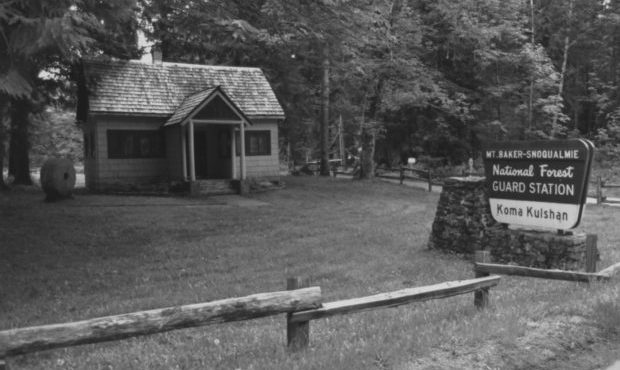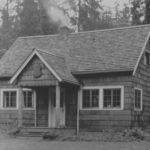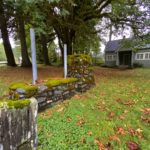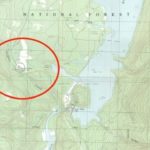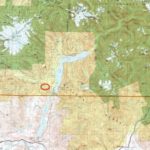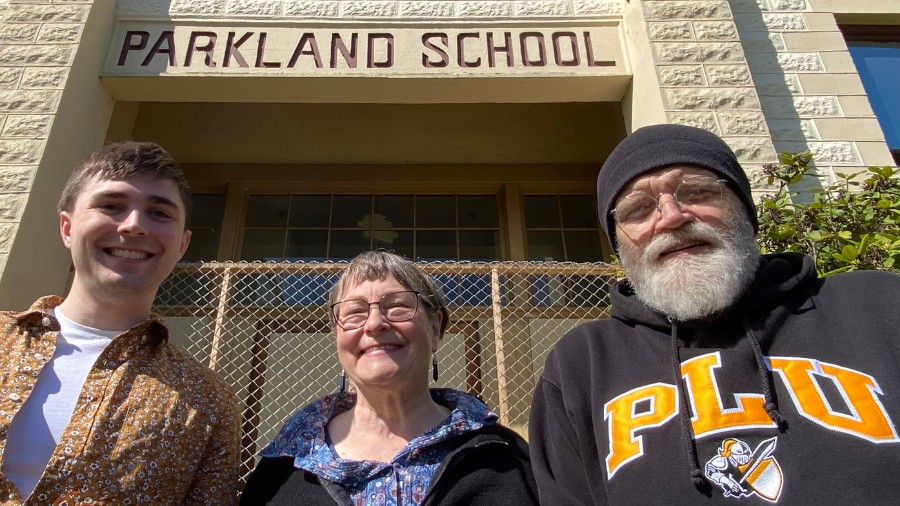If Mount Rainier’s name is changed, what about Mount Baker?
Apr 28, 2021, 9:39 AM | Updated: 3:35 pm
Last week, KIRO 7 TV reported that the Puyallup Tribe is launching a new effort to restore the Indigenous name “Tacoma” to Mount Rainier.
But what about Mount Baker, which was given that name 229 years ago this week?
Unlike the battle between Seattle and Tacoma civic leaders over the name of Mount Rainier — which goes way back to the 1890s – or even the new efforts of the Puyallup Tribe, there doesn’t appear to have ever been the same level of conflict or even any dispute over the name of Mount Baker. However, it turns out that there is confusion over what the true Indigenous name for Mount Baker really was – if there ever was a single Indigenous name for the Whatcom County Cascade peak.
When Spanish explorers led by Manuel Quimper visited the area in 1790, they called the mountain “La Montaña del Carmelo” – reportedly, according to some sources, because the mountain resembled the white robes of Carmelite monks. But the Spanish didn’t stick, because the Spanish didn’t publish any journal accounts or nautical charts; their exploration was more about gathering intelligence, and Spanish efforts to colonize what’s now the Pacific Northwest fell by the wayside.
It was, not surprisingly, the ubiquitous and prolific Captain George Vancouver of Britain who named the mountain for 24-year old Third Lieutenant James Baker – the first member of the crew of the HMS DISCOVERY to spot the peak. And young Baker’s sharp eyes first fell on the snowy cone from somewhere near Dungeness Spit around 5 p.m. – 229 years ago this week, on April 30, 1792.
Many Northwesterners have memories of being told as children or reading in pamphlets or on interpretive signage that the “Indian name” for Mount Baker was “Koma Kulshan,” which was also often said to mean “white and steep.” In 2021, the name “Koma Kulshan” appears in many places – as recently as last month in the Seattle Times Sunday magazine, and in a MyNorthwest story a few years ago about Mount Baker’s steam eruptions of 1975.
However, in the past decade or so, there have been new theories about “Koma Kulshan” hatched by a retired anthropology professor in Bellingham named Allan Richardson and first published by the Whatcom County Historical Society. Professor Richardson has been studying Indigenous languages in the Northwest for decades; he co-authored a Nooksack Place Names guide, and he believes he has untangled the origins of “Koma Kulshan” – as well as why it’s not exactly correct.
Richardson told KIRO Radio that sometime around 1912, a civic promoter in Bellingham named Charles Finley Easton interviewed a Lummi elder in his 70s or 80s named Kwina.
“Kwina in 1912 didn’t speak much English and they were getting translated,” Richardson said, while pointing out that many different languages were spoken by Indigenous groups in what’s now the Pacific Northwest – there wasn’t just one single native language here. “His mother was actually from Puget Sound, farther south, near Seattle, and ‘Tacoma’ would have been her name for Mount Baker, and ‘Kwelshán’ would have been his father’s name for Mount Baker.”
“And it’s possible,” Richardson continued, “that was our best guess, is that somehow the two [names] were intermingled in the interview, so the local promoter said, ‘Aha! This is the Indian name for Mount Baker.’”
What Richardson theorizes is that Charles Finley Easton, based on translation difficulties, put together two separate names for Mount Baker from two separate Indigenous languages to create something no one had ever actually used for the mountain’s name.
In this theory, “Koma” is a variation or shortened version of “Tacoma” – which is, essentially, a Lushootseed word for a big mountain, which is the same word considered to be Mount Rainier’s Indigenous name. “Kulshan” (or “Kwelshán”) is a Lummi variation of a Nooksack word meaning “the shooting place” – for hunting – or perhaps referring to the volcanic activity atop the mountain, with the steam and fire erupting from the crater meaning it had been shot with an arrow and was bleeding.
Charles Finley Easton put these two words together as “Koma Kulshan,” which Richardson says is not really correct. That is, no Indigenous person ever called Mount Baker “Koma Kulshan,” and the single word “Kulshan” would have been a more accurate and more appropriate choice. And that purported “white and steep” meaning of “Koma Kulshan” was not accurate, either.
Easton was a promoter of all things Bellingham, Whatcom County, and particularly Mount Baker, and he published a pamphlet about Koma Kulshan in 1912. The name caught on, with several clubs and organizations adopting it in tribute to the mountain’s Indigenous past. In 1933, the United States Forest Service, with help from the Depression-era Civilian Conservation Corps, built a ranger station not far from the Baker River Valley. The location was chosen to be near where a newly constructed road reached the area from the town of Concrete in the Skagit Valley to the south.
The new facility, with its breathtaking views of Mount Baker, was called Koma Kulshan Ranger Station. Owing to administrative changes (and the creation of the Upper Baker Lake Dam, which flooded much of the Baker River Valley, and inundated the site of another ranger station, beginning in the late 1950s), the building has been known for decades as the Koma Kulshan Guard Station. Several buildings there are listed on the National Register of Historic Places, and the complex has been home for many years to a wildfire suppression team called the Baker River Hotshots.
Does having the inaccurate “Koma Kulshan” name attached to a federal facility do harm, in that it codifies and gives a certain blessing to an honest mistake made in 1912? KIRO Radio checked with officials from the Mount Baker-Snoqualmie National Forest to see if any individual or group has ever expressed interest in changing the name of the building, perhaps shortening it to the more accurate “Kulshan Ranger Station.”
“This is really the first that we’ve heard of any suggestions to change the name of the Koma Kulshan Guard Station,” said Colton Whitworth, public affairs officer for the Mount Baker-Snoqualmie National Forest. “Our response to any folks that would suggest the name change would be that we’re going to work with our tribal partners, and if there’s ever a suggestion from them, especially, then we wouldn’t hesitate in taking care of whatever request that they would like to do, and working with them to either change the name or however we would need to do it.”
“It’s not something that we would be opposed to,” Whitworth said.
The tribal partners that Whitworth mentioned would include the three tribes closely associated with Mount Baker on the American side of the border – Lummi, Nooksack, and Upper Skagit — all of whom had different names for different aspects of the peak in different languages that reflect the multiple roles the mountain played in practical, cultural, and spiritual realms, along with what activities took place there, as well as whether the mountain was nearby or in the distance. And at least one Indigenous language north of the border — Halkomelem — had a name for Mount Baker, too.
Scott Schuyler is Cultural and Natural Resources Policy Representative for the Upper Skagit Tribe, which is made up of bands that have inhabited the Skagit Valley and the Baker River Valley – including the area around the Forest Service facility – for 8,000 years. Renaming Koma Kulshan Guard Station is not something that’s been on their radar, either.
“It hasn’t been an issue for us,” Schuyler told KIRO Radio. “I would just point out there’s always historical inaccuracies because you had the tribes in different areas. We had, of course, the Upper Skagit in the Baker Valley, and Nooksack across the mountain on the other side, and Lummi to the west.”
“Each had their own place names and names for certain points,” Schuyler said.
Schuyler says the Upper Skagit Tribe would need to consult with elders and tribal government before taking any formal position on changing the name of the Koma Kulshan Guard Station. George Swanaset Jr., Natural and Cultural Resources Director for the Nooksack Tribe told KIRO Radio essentially the same thing, while a spokesperson for the Lummi Nation deferred to the chairman, who was not available for an interview.
Meanwhile, Colton Whitworth told KIRO Radio that the Forest Service isn’t necessarily going to wait.
“We have a Tribal Liaison intern that works very closely with the Lummis,” Whitworth said. “And we’re actually going to have him reach out to them to see if this would be something that they would like to see changed.”
In a follow-up email, Whitworth emphasized that the Forest Service is committed to being in dialog with all of its tribal partners.
And, while changing the name of a single Forest Service building is one thing – which sounds like it could be a fairly simple process – might the renaming Koma Kulshan Guard Station be the beginning of a larger effort to restore an Indigenous name to Mount Baker? That’s hard to say, and the decision about Mount Baker wouldn’t be up to just the Forest Service.
“The peak recorded as Mt. Baker on U.S. Geologic Service maps is important to many tribes,” Whitworth wrote. “We recognize different tribes may have different connections to the area, and we want to respect each tribe’s interests and relationship with this special place. … If tribes choose to bring forward a proposal for change in place names, whether Mt. Baker or other locations, we will listen and work with tribes, as the trustee of their rights and interests, on a meaningful path forward.”
“Ultimately, the decision on place names resides with another federal agency,” Whitworth wrote.
That other federal agency is the U.S. Board on Geographic Names (USBGN), a part of US Geological Survey within the Department of the Interior – which, incidentally, includes “Koma Kulshan” in its official database of name variants for Mount Baker. With the recent restoration of Denali in Alaska to what had been Mount McKinley, and with the recent confirmation of Secretary of the Interior Deb Haaland – the first Indigenous person to hold that job, it may be more likely than ever before that efforts to replace long-standing, non-Indigenous place names will be likely to succeed. If federal receptiveness is any indication, at last check, the homepage of the USBGN features a link to a page called “How to Propose a New Name or a Name Change for a Geographic Feature in the U.S.”
Whatever happens to Koma Kulshan Guard Station in the near-term, Lummi elder Kwina’s conversation with Charles Finley Easton more than a century ago might be a good indicator to professor Allan Richardson of how challenging it could be to reach consensus around a single Indigenous name for the volcanic peak.
“Do you use the Nooksack name? Do you use the Lummi name? Do you use the Skagit name? Whose name do you use?” Richardson asked. “When you have four or five different Native languages – or six, if you count people out in the islands far enough where they could see Mount Baker – but each had a different name for the mountain.”
“How do you choose a name?” Richardson said. “I don’t know, but ‘Kulshan’ or ‘Kwelshán’ is probably the closest thing to something that people might agree to.”
You can hear Feliks every Wednesday and Friday morning on Seattle’s Morning News, read more from him here, and subscribe to The Resident Historian Podcast here. If you have a story idea, please email Feliks here.

